Tag: burtonmath11
Week 17 in Precalculus
This week in Precalc 11 we learned a new trigonometry formula known as the sine law. Sine law is used to find the angles and side length of triangles that don’t contain a ninety degree angle. To use this formula you need 3 pieces of information, 2 of which must correspond to one another. For example if you have angle C you need the side length c.

The equation you can use for sine law is:

The equation for sine law can be reciprocated depending on what you are trying to find. If you are looking for an angle, you would put the sin’s in the numerator and the side length in the denominator. Vise-versa with finding a side length.
When solving with sine law, you must choose on fraction that has a completed numerator and denominator and another fraction that has either the numerator filled out or the denominator.

Then you must isolate the variable. To do this you have to get rid of the uncompleted fractions denominator and you also must get rid of the trig function attached to the variable on the numerator. To do this you must take sin and inverse it. For example:

Week 16 in Precalculus
This week in Precalc 11 we learned how to multiply and divide rational expressions. The General rule for doing this is:
1. Factor (numerator and denominator)
2. Use exponent laws
3. Cancel out like terms
this process is much like cross multiplying, for example:

since these fractions can get pretty long and “ugly”, writing them out is helpful and easier to manage. If you follow the 3 main rules as well than solving is much more efficient.
Monomials are easier because you can combine the numerators and denominators than simplify.

When it is a single variable expression you must factor in order to simplify. You can only cancel out EXACT terms. The + or – signs act as unpenatratable glue. They connect the numbers on either side of the sign, acting as a package.
To cancel out you can use the cross multiplication technique. Then combine the leftover numerators and denominators.
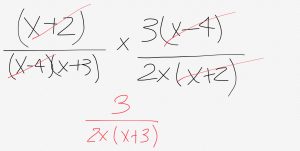
The last thing you must do, which you actually do first, is find the non-permissible values. A non-permissible value is the numbers which make the denominators equal to zero. You find these once you have factored.
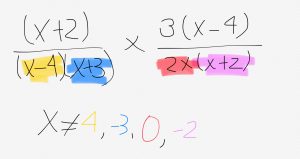
Week 12 in Precalculus
this week in Precalc I learned how to graph linear inequalities that contain 2 variables. Solutions to a liberal equation with 2 variables is represented by a boundary line and shading in one side.
A solid line for an inequality:

A broken line for an inequality:

to graph it you take the line and convert it to y=mx+b form. Things to look for in this form is the: Y-intercept so you have a point to start from, the X coefficient so you know the rise over run, and the inequality sign to figure out if the boundary line will be solid or broken.

Once you’ve graphed the equation, choose a test point. You can choose any point and plug it into the x and y spot. If the equation is proven true after solving, than you shade that section. If not the equation is false and you shade the other section. The two test points I’ll use is (0,0) and (-5,5)


Week 11 in Precalculus
This week in Precalc 11 we learned how to solve a quadratic inequality with one variable using a sign Chart.
The steps when using a sign chart is to:
1. Factor expression
2. Determine zeros
3. Use a sign chart for each factor
for example, take this equation and make it equal to zero the factor.
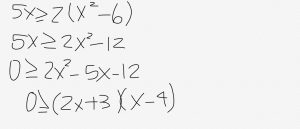
Once you have factored determine the zeros (-3/2 and 4) and place them on two number line. Each number line will represent a different factor. One will be (2x+3) and one will be (x-4).

For each factor do a test point in all 3 sections. Pick a point less than -3/4, between -3/4 and 4, and greater than 4. Plug these test points in to the factor and determine whether the outcome is negative or positive.
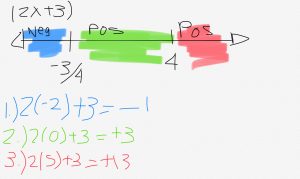
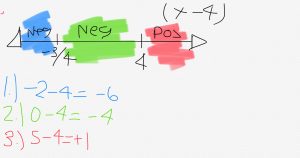
Add up the positives and negative of the two number lines to determine what the equation will finally equal.

Since the equation is asking for the equation to be less than zero we want x to be negative.

Week 10 in Precalc 11
This week in precalculus 11 I worked on remembering how to find the common difference of an arithmetic pattern and the common ration of a geometric pattern.
A common difference is what the Arithmetic pattern goes up or down by. An arithmetic sequence goes up by the same amount each time.
You can subtract two consecutive terms and can find the common difference.

For example:


For geometric sequence each term is multiplied by a constant known as the common ration. The common ration can be found by dividing a term by the previous term. For example:
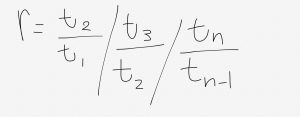

Generally:

i also worked on figuring out if an equation diverges or converges.
If an equation diverges it means there is no sum. It is either greater than one or less than negative one= r>1 & r<-1
if an equation converges it has a sum. The solution falls between 0 and 1 and -1 and 0.
0<r<1
-1<r<0
if an equation converges it will be a fraction.
Week 9 in Precalc 11
This week in precalculus we learned how to solve modelling problems involving money; also known as revenue.
An example of this problem is: “a company cancel a phone for $500. At this price they can sell 60 phones. Every $50 increase, the number of phones sold will drop by 4. What price will result in the maximum revenue.
Some of the key information here would be maximum, telling us that the parabola would be negative meaning opening downward.
The equation for revenue is : a Price x the number sold. So our equation would be:

the x in the equation represents the price increase. The way the equation is set up right now is called factor form. In this form we can extract the roots, or, the x intercepts.

Since we have the roots we can also get the line of symmetry. To do this you add the zeros together and than divide by two. You do this because the line of symmetry is found in the middle of the x intercepts.

Since the line of symmetry is also equal the the x value of the vertex, we can take this value and substitute it into the x value of the equation.

So the maximum revenue venue would be an increase of $2.50 which will result in $31,250.
Week 8 in Precalc 11
This week in precalculus we analyzed the quadratic function. In the equation each letter/ variable represents something that can change the graph. The standard form or the vertex form is:

with this equation the variable “a” controls the expanding of the parabola. Meaning, it makes the graph skinny or wide. When y= The pattern for the graphs wideness is 1,3,5,7 or when a=1

when a>1 the graph slenders. For example: y= 5

when 0<a<1 the graph widens. For example: y= 0.5

And when a<0 or when it’s negative the graph reflects down meaning it opens downward for example: y= -2

The “P” in the equation represents the horizontal translation or slide if the number is negative it moves right and if it’s positive it moves left. For example: y= or y=


The “q” of the equation represents the vertical translation. If it is positive it moves up, if it was negative it would move down. For example: y= +3 or y=
-3


The (P,Q) represent the vertex coordinates. P=X and Q=Y
 Loading...
Loading...
Week 7 in Precalc 11
This week in precalculus 11 we looked at discriminants. A discriminant is a part of the quadratic formula and can determine the number of solutions in a quadratic equation without solving the equation. This is the formula you use for discriminant:

To solve a discriminant you place the proper coefficient in its corresponding spot:

once you have put the coefficients in the proper place you solve as regular.
If the discriminant is postitive after solving is complete, this equation has 2 solutions and is an unequal, real root, for example:

if the discriminant is equal equal to zero after solving, the equation has one solution and is equal, real root. For example:

And if the discriminant is negative after solving, there are no solutions and is an unreal root. For example:

Week 6 in Precalc 11
This week in Precalc us 11 we learn how to solve quadratic equations using the Quadratuc formula. The quadratic formula is:

with this formula the term “a” cannot equal zero. To solve this equation you must you take the equation and have it equal zero. For example:

after the equation equals zero you must put the terms in to their corresponding spot in the formula.

Make sure to include the sign (negative and positive) when transferring these terms.
Then, you solve:

when you have your two possible answers you can keep it in the form you solved to. This is called an exact value but, if you were to use a calculator and calculate your answer into decimal for, this would be an approximate value.

Week 4 in Precalc 11…Updated
This week in math 11 we learned how to multiply Radicals. Multiply Radicals is quite similar to distribute property. For example:

when you multiply you you can only multiply coefficients with other coefficients and multiply radicnads by other radicands. You cannot multiply a radicand by a coefficient, a coefficient can only go with a coefficient and a radicand can only go with a radicand.

Remember to simplify by finding a perfect square, cube, fourth root, fifth root, etc. That divides into it. Then take it out of the radicand and multiply it by the coefficient.

Remember “invisible” square roots and coefficients. For example:
